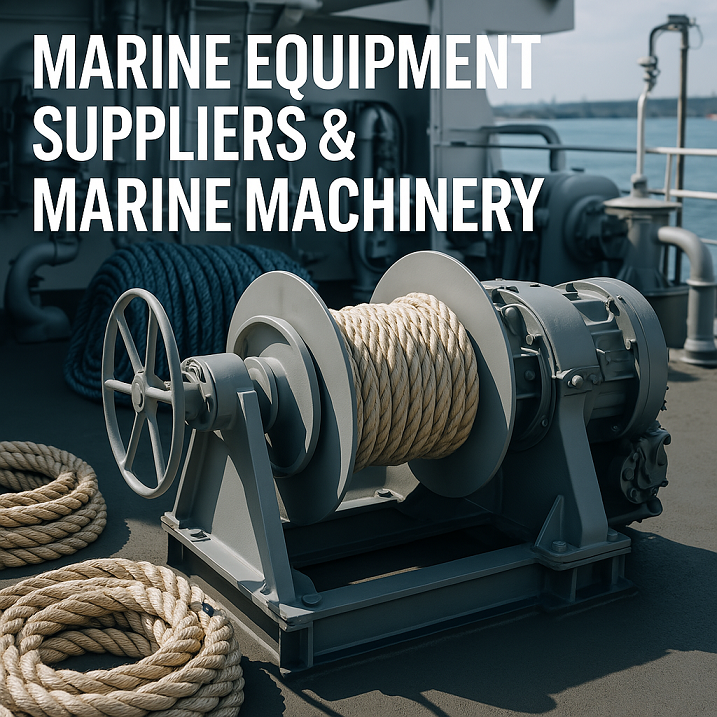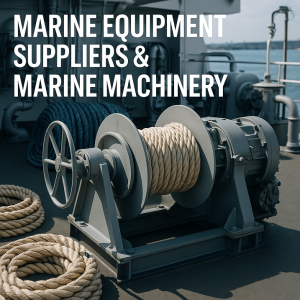Discover the essential role of marine equipment suppliers and machinery in modern shipping. Learn about types, suppliers, applications, and trends. A comprehensive guide for maritime students, cadets, officers, and shipping companies.
Who Keeps Ships Running Smoothly?
From the main engine to the lifeboat davits, every ship depends on a complex network of marine equipment and machinery. But have you ever wondered who supplies this gear, how it is selected, and why it is critical for vessel safety, performance, and compliance?
This article dives into the world of marine equipment suppliers and marine machinery—covering key definitions, types, top global suppliers, use cases, and future trends. Whether you’re a maritime student, cadet, engineer, or part of a shipping company, this guide offers practical, SEO-optimized insights tailored to your role.
What Are Marine Equipment and Marine Machinery?
⚓ Marine Equipment:
Refers to the auxiliary systems, tools, and accessories installed on ships to support daily operations, navigation, and safety.
Includes:
-
Lifesaving appliances (lifeboats, EPIRBs, life rafts)
-
Firefighting systems (sprinklers, CO₂ systems)
-
Mooring gear (winches, ropes, anchors)
-
Navigation aids (radar, ECDIS, compasses)
⚙️ Marine Machinery:
Encompasses the mechanical and electromechanical systems required for vessel propulsion, power generation, and onboard operations.
Includes:
-
Main propulsion engines and shafting
-
Diesel generators
-
Pumps and compressors
-
Boilers and heat exchangers
-
Steering gear and stabilizers
🧠 While marine equipment enhances functionality and safety, marine machinery forms the vessel’s mechanical backbone.
Types of Marine Equipment & Machinery (With Examples)
🛠️ Propulsion and Power Systems
-
Main engines (MAN, Wärtsilä, Caterpillar)
-
Shaft lines and gearboxes
-
Generators and alternators
-
Electric propulsion and hybrid systems
💨 Air, Fuel & Water Systems
-
Fuel treatment and transfer systems
-
Freshwater generators and desalination units
-
Bilge and ballast pumps
-
Air compressors for automation
🧯 Safety and Environmental Equipment
-
Fire detection and extinguishing systems
-
Sewage treatment plants (STP)
-
Scrubbers and Ballast Water Management Systems (BWMS)
-
Emergency shutdown valves and gas detectors
⚓ Deck and Cargo Handling Equipment
-
Winches, cranes, hatch covers
-
Cargo pumps for oil/chemical tankers
-
Davits and lifeboat release systems
🌐 Navigation & Communication Systems
-
Radar, sonar, GPS, AIS
-
ECDIS (Electronic Chart Display)
-
GMDSS (Global Maritime Distress and Safety System)
Role of Marine Equipment Suppliers
📦 What Do Marine Equipment Suppliers Provide?
-
OEM parts and replacement components
-
Technical consultancy and specification support
-
Logistics and just-in-time delivery to ports worldwide
-
Commissioning, training, and post-sales support
⚠️ Choosing the right supplier ensures not only operational continuity but also compliance with IMO, SOLAS, MARPOL, and class society requirements.
Top Marine Equipment Suppliers Globally
| Supplier / Manufacturer | Known For | Country |
|---|---|---|
| Wärtsilä | Engines, hybrid propulsion, scrubbers | Finland |
| MAN Energy Solutions | Two-stroke and four-stroke engines | Germany |
| Alfa Laval | Heat exchangers, fuel systems, BWMS | Sweden |
| Hamworthy Pumps | Pumps for engine room and cargo systems | Denmark |
| Kongsberg Maritime | Navigation, automation, control systems | Norway |
| ABB Marine | Electric propulsion, switchboards | Switzerland |
| Rolls-Royce Marine (now Kongsberg) | Deck machinery, propulsion | UK/Norway |
💡 Many suppliers also work through authorized marine dealers and ship chandlers in key global ports such as Rotterdam, Singapore, Dubai, and Shanghai.
Importance for Maritime Students, Cadets & Professionals
🎓 For Students & Cadets:
-
Understand system functions and technical specifications
-
Study installation, maintenance, and emergency procedures
-
Familiarize with leading equipment brands and manufacturers
🧭 For Ship Officers & Engineers:
-
Operate and maintain marine machinery effectively
-
Conduct troubleshooting and diagnostics
-
Ensure machinery complies with SOLAS and class survey requirements
🏢 For Shipping Companies & Ship Managers:
-
Optimize procurement with cost-effective, reliable suppliers
-
Plan preventive maintenance using OEM standards
-
Implement green technology upgrades for regulatory compliance
Trends and Innovations in Marine Equipment & Machinery
🌱 1. Green and Energy-Efficient Solutions
-
Hybrid and fully electric propulsion systems
-
Energy-saving devices (ESDs), such as propeller boss cap fins
-
Scrubbers and selective catalytic reduction (SCR) for emissions control
🤖 2. Digital Monitoring and Smart Maintenance
-
Condition-based maintenance using IoT sensors
-
Remote diagnostics and performance analytics
-
Digital twins of engines and power systems
🛰️ 3. Integrated Automation and Bridge Systems
-
Vessel-wide control from a single bridge console
-
Integrated systems reduce crew workload and enhance safety
🔐 4. Cybersecurity in Marine Machinery
-
Secure operation of digitalized equipment
-
Compliance with IMO 2021 Cyber Risk Management resolution
FAQs: People Also Ask
What is marine equipment used for?
Marine equipment ensures the safe and efficient operation of a ship. It includes safety gear, navigation tools, cargo handling systems, and environmental protection devices.
What is marine machinery?
Marine machinery includes all mechanical systems used for ship propulsion, power generation, steering, and fluid systems (e.g., ballast, fuel, bilge).
Who are the top marine equipment suppliers?
Top companies include Wärtsilä, MAN Energy, Alfa Laval, ABB Marine, Kongsberg Maritime, and Rolls-Royce Marine.
How do marine equipment suppliers ensure compliance?
They provide certified products that meet IMO, SOLAS, MARPOL, and class society standards such as DNV, ABS, LR, and BV.
Conclusion: Building a Safe and Sustainable Maritime Future
Whether you’re building a new ship, upgrading an old vessel, or training for your first role as a marine engineer, understanding marine machinery and the role of equipment suppliers is vital. These systems are not just technical assets—they are the engines of global trade, safety, and sustainability.
⚓ Next Steps:


